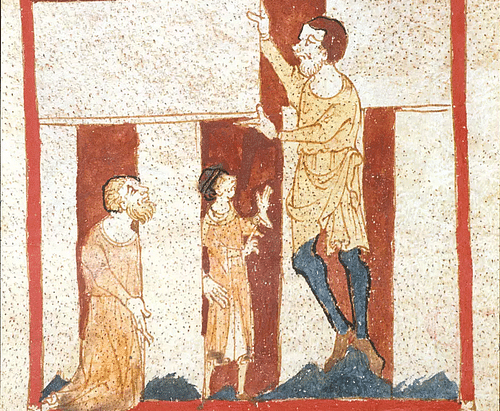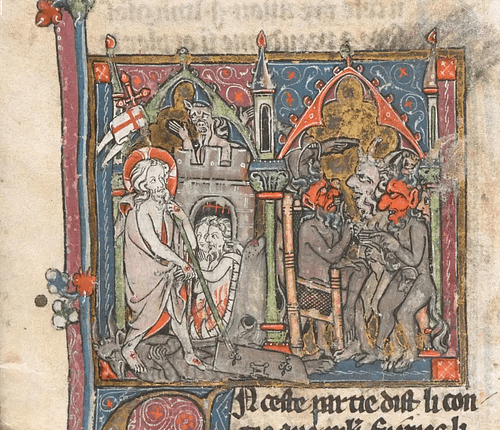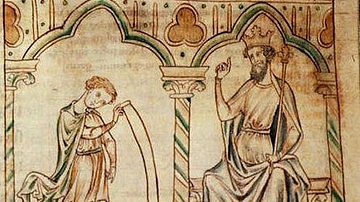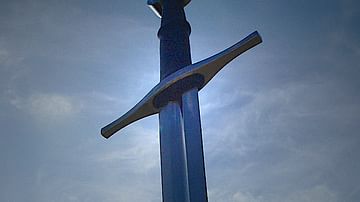
Merlin (also known as Myrddin, Merlinus) is the great wizard of the Arthurian Legends best known from Sir Thomas Malory's Le Morte D'Arthur (1469 CE). The character was created by Geoffrey of Monmouth in his History of the Kings of Britain (1136 CE) where he first appears as a wise and precocious youth with prophetic powers. The French poet Robert Wace (c. 1110-1174 CE) then translated Geoffrey's work and added to it in his Roman de Brut (c. 1160 CE). Merlin was later featured as the central character of the Merlin by Robert de Boron (12th century CE) who cast him as a Christian prophet, and this depiction, with some variation, would continue in the Vulgate Cycle (1215-1235 CE) and the Post-Vulgate Cycle (c. 1240-1250 CE) to influence Malory's final characterization of the seer.
In Malory, Merlin is Arthur's mentor, instrumental in every aspect of his life from his conception to his education, his rise to power, and his vision of a kingdom ruled through justice and goodwill. Merlin is central to the lives of all the main characters of the legend, able to see both past and future, eager to advise and be of service, but unable to alter what he knows must be.
From his earliest appearance in medieval literature, Merlin has remained among the most popular characters in the legends. He may have originally been a fertility god or spirit, feared or revered for his great wisdom and magical abilities, and this concept of Merlin was revived in 19th-century CE romantic literature. Since then, he has appeared in or influenced numerous works of fiction, film, and other media, almost always depicted or referenced in this same way, as a powerful mage.
Name & Origin
Merlin first appears in literature in the History of the Kings of Britain by the Welsh cleric Geoffrey of Monmouth (c. 1100 - c. 1155 CE). The Merlin character's name is not a proper name (designating an individual in this case) but a toponym (a place name), specifically the Welsh Caermyrddin (“Merlin's Town”), referring to the city of Carmarthen, Merlin's birthplace. Geoffrey Latinized Myrddin as Merlinus because the strict Latinization of Merdinus would have associated the name with the Latin merdus (feces, dung). The character originated in Welsh folklore featuring the wildman-in-the-woods motif, a half-savage who lived on the fringe of civilization possessing great power and wisdom.
The most famous Welsh wildman was Myrddin Wyllt (“Myrddin the Wild”), a 6th-century CE bard who was said to have gone insane after a particularly bloody battle and retreated to the woods. Geoffrey wrote a short work, The Prophecies of Merlin (c. 1130 CE), prior to his famous history but this Merlin has nothing to do with the wizard of the Arthurian Legends. After the success of his History, Geoffrey wrote another work, The Life of Merlin (c. 1150 CE), in which the main character exhibits magical and prophetic skills but this work is unconnected to the Arthurian Legends.
Geoffrey's Merlin
In Geoffrey's History, Merlin features as a prominent character in Books VI-VIII. King Vortigern, the usurper, is having trouble building a tower because the foundation will not stand firm. His wizards advise him to find a youth in the kingdom who had no father and sacrifice him, sprinkling his blood with the mortar, and then the foundation would be sound. Vortigern sends out his ministers to find such a youth, and they come upon Merlin whose mother tells them he has no earthly father but that she was visited by a spirit who took the form of a man and impregnated her.
Merlin is brought before the king who explains his problem and how he must sacrifice the boy, but Merlin, unimpressed, commands the wizards be brought to him so he can show they are lying. He asks them what is beneath the foundation that prevents it standing firm, and they cannot answer. He then tells Vortigern that he will find a pool beneath it and tells him to call his workmen and rip the foundation up. They find the pool as Merlin said, and he then asks the wizards what is in the pool. Again they cannot answer, and Merlin tells them they will find two hollow stones and two sleeping dragons inside, one white and one red, all of which they find when they drain the pool.
In Book VII, Merlin interprets the meaning of the dragons and foretells the future. The red dragon symbolizes the Britons and the white one the Saxons whom Vortigern has invited into his kingdom. The white dragon will oppress the red dragon until the Boar of Cornwall rises to drive the Saxons out; a prophecy concerning King Arthur and his future victory over the Saxons. Vortigern's illegitimate rule is challenged in Book VIII by the noble Ambrosius Aurelius and his brother Uther Pendragon and, when Vortigern is killed, he is succeeded by Ambrosius.
The kingdom is still in conflict, however, and Ambrosius must battle the Saxons. After a great victory, he commands a memorial to be built and Merlin moves the giant mystical stones from Mount Killare in Ireland to Amesbury outside London for this purpose, thus creating Stonehenge. Ambrosius is killed by the Saxons, and Uther then becomes king and allies with Gorlois of Cornwall but falls in love with Gorlois' wife Igerna.
Merlin casts a spell which makes Uther look like Gorlois, and he sleeps with her, thus conceiving Arthur. Gorlois dies in battle and Uther marries Igerna and then sometime later dies from drinking from a spring poisoned by his Saxon enemies. Arthur becomes king, avenges his father and uncle, and drives the Saxons from Britain. Merlin disappears from the narrative after arranging Uther's night with Igerna with no explanation given. Books IX-XII of the History focus on Arthur's conquests, his betrayal by Mordred who abducts Guinevere, and the Battle of Camlann in which Arthur is mortally wounded and his knights mostly killed.
Wace, Chretien, & Robert de Boron
Robert Wace translated Geoffrey's History but added to the story from his imagination. Like many French poets of his time, he was patronized by Eleanor of Aquitaine (c. 1122-1204 CE) to whom he dedicated the work. Wace is responsible for some of the most famous aspects of the Arthurian Legends such as the Round Table and the name of Arthur's sword, Excalibur. He also developed the main characters more fully, especially Merlin in the Stonehenge episode which, although it follows Geoffrey's closely, makes more of Merlin's magical abilities.
The great Arthurian poet Chretien de Troyes (c. 1130-1190 CE), mentions Merlin only once in his Erec and Enide (lines 6617-6618) and only in reference to a tradition dating back to Merlin's time. Robert de Boron is the next to develop the character from Wace's work in his Merlin (c. 1200 CE). This poem opens with a group of demons plotting the destruction of the world by creating a supernatural being whose evil will rival the good of Christ. This creature will be half-human and half-devil and, to that end, they possess a pious man of means and sleep with his daughter. The daughter tells her confessor what happened (seemingly knowing her father was possessed) and he blesses her with the sign of the cross as protection; now the child will be born with supernatural abilities but without the evil spirit the demons were counting on.

When Merlin is born, he is baptized, and this ritual along with his mother's natural piety and goodness and the protective blessing she received shortly after conceiving Merlin, all contribute to his nature as inherently good while the supernatural circumstances of his conception endow him with skills in magical arts. He can speak almost as soon as he is born, and before he is three years old is able to tell the story of Joseph of Arimathea and how he brought the Holy Grail to Britain (the subject of Robert de Boron's earlier poem Joseph of Arimathea). Merlin grows up with his mother in peace until the usurper king Vertigier sends out his ministers to find a fatherless child to sacrifice because the foundation of his tower will not stand firm.
Robert's narrative then follows Geoffrey's and Wace's almost exactly, right down to Merlin disguising Uther as the husband of the beautiful queen (named Ygerne here) and Arthur's conception. When Arthur is born, Uther gives him to Merlin who places him with a foster family who know nothing of his royal birth. Arthur's identity is revealed when he draws the sword of the king from an anvil, thus establishing himself as the son and heir of Uther.
Robert's Merlin is a sequel to his earlier Joseph of Arimathea and was possibly the second work of a trilogy which concluded with a work on Perceval and the grail. Robert's most significant contribution to the Arthurian tales was their Christianization which would influence later writers. The grail, previously a platter, now became the Holy Grail, the cup of Christ. Merlin, though still a fringe figure, became a Christian seer and Arthur and his knights became champions and defenders of the Christian cause. Arthur as a Christian king is evident from Geoffrey onwards, but in Geoffrey's History and Wace's Brut, Arthur is fighting for his country and people first and calling on Christ to support that effort; after Robert de Boron, Arthur is in service to Christ first and all his great accomplishments follow from his devotion to God.
Vulgate Cycle & Prose Merlin
The Vulgate Cycle continued and developed this tradition and also marks the first time the Arthurian Legends appear in prose. In the Middle Ages, prose was used for works on history, theology, or philosophy which were considered “serious” subjects; poetry was used for works of the imagination. The anonymous authors of the Vulgate Cycle chose their form purposefully because they wished to present the subject as actual history, not fanciful romance.
The Vulgate Cycle begins with a history of the Holy Grail, moves to Merlin's birth and involvement with Arthur, highlights Lancelot's affair with Guinevere, establishes the importance of the knights' quest for the Holy Grail, and ends with Arthur's death after the Battle of Camlann. The Vulgate Cycle (edited and revised as the Post-Vulgate Cycle) inspired another work, the Prose Merlin. This piece, dated to the mid-15th century CE (shortly before Malory wrote Le Morte D'Arthur), was written in Middle English and focuses entirely on Merlin as hero and central character against the backdrop of the Arthurian world.
The Prose Merlin relies heavily on Robert de Boron's Merlin but adds significant details such as the specific reason for the demon's plot to impregnate a female human with a demonic child. As referenced in the Bible, following Christ's death on the cross he descended into hell to free the patriarchs imprisoned there (an act known as the Harrowing of Hell). This event upset the balance of hell and so the demons enact their plan to create a human agent on earth who will counter Christ's rescue of the souls and send more down to Satan's realm. The author also explains that Merlin was named for his pious Christian grandfather, thereby cutting any association of the seer with Myrddin of the Welsh pagan tradition.

The Prose Merlin follows Robert de Boron for its first five sections which are then followed by two sequels known by scholars as the historical continuation (Prose Merlin Sequel) and the romantic continuation (Suite du Merlin, also known as the Huth Merlin because it is contained in the Huth Manuscript of the British Library). The historical continuation picks up where Robert's Merlin ends, with Arthur drawing the sword from the anvil, (only now it is a sword in a stone), and then tells the story of Arthur's struggle against his rebellious barons, formation of the court, and exploits.
The romantic continuation develops all of the more mythical aspects of the Arthurian Legends such as Arthur receiving Excalibur from the Lady of the Lake, Arthur's enchantment which leads to him fathering Mordred, the formation of the Round Table, the Lancelot-Guinevere affair, and how Nimue (also given as Vivienne and Niniane in other works, Merlin's protégé and lover) traps Merlin, sealing him forever in a world he cannot escape which only she has access to, thus condemning him to an eternal death-in-life and removing the character from the narrative. All of the more resonant elements of the Arthurian universe are developed in this work but Malory would bring the story further to its finished form.
Malory's Merlin
Sir Thomas Malory was a political prisoner at Newgate, London 1468-1470 CE when he wrote Le Morte D'Arthur. Although his primary source was the Post-Vulgate Cycle, scholars agree that he probably had access to a good library and was well-read in Arthurian lore. Malory's Merlin is the final culmination of all the other versions of the seer pre-1469 CE: a powerful wizard of prophetic insight who can control the elements, shape-shift, alter other people's perception of reality, and read people's hearts and true desires. Malory almost certainly drew on the Prose Merlin for the core of his character but developed him to a much deeper degree.
As in the earlier works, Merlin is born of a noble woman and a demon, assists Uther in conceiving Arthur, and places the boy with the foster family of Sir Ector after his birth. Arthur grows up as squire to his older foster-brother Kay and serves him at tournaments. At one such event, he finds he has forgotten to bring Kay's sword from the tent and, on his way back, sees a sword in a stone. He draws it and brings it to Kay who recognizes it as the king's sword and tries to pretend he drew it but he is found to be lying. Arthur then returns the sword to the stone and again draws it easily, proving he is the heir to the throne.
Merlin returns to Arthur's life after this event, counsels him in kingship and just rule, and remains an ever-present figure orchestrating events behind the scenes or trying to convince others to listen to their better natures. He tells Arthur that Guinevere will be unfaithful to him with Lancelot the moment Arthur announces his intention to marry her but Arthur will not listen. Merlin grooms Nimue as his successor and falls completely in love with her, losing his perspective. He has no idea how ambitious Nimue is until after he has taught her the breadth of his magical knowledge and she then imprisons him. With Merlin gone, Arthur loses his trusted counselor, and once the affair of Lancelot and Guinevere comes to light, the unity and vision of the Round Table is lost, Mordred usurps the throne, and the kingdom falls after the climactic Battle of Camlann.
Conclusion
Throughout all of these works, Merlin is central to the narrative and the character remains among the most popular of the Arthurian Legends. Welsh writers following Geoffrey wrote their own works about the seer. Italian and Spanish poets drew on the French and Welsh traditions to feature Merlin in their own works and his popularity is attested by the number of complete works or fragments of manuscripts from the Middle Ages which mention or feature him. Scholar Peter H. Goodrich comments:
Merlin, the prophet and magus, is historically the second-best known character from medieval literature, barely outstripped by his liege lord King Arthur. Beyond literature, he has entered our public consciousness to an even grater extent than Arthur, through the association of his name with all kinds of technological devices and commodities, many of them not in the least Arthurian. (1)
The character has influenced the concept of the wizard, mage, sorcerer, and wise man since his first appearance in Geoffrey's History and writers such as J.R.R. Tolkien, C.S. Lewis, and J. K. Rowling, among many others, have acknowledged as much regarding their works. Scholar William W. Kibler notes how this is due to the compelling nature of the character:
Merlin is constantly at the center of the action, predicting events and using his magical powers to control history. He is puckish and benevolent and constantly makes use of his shape-shifting powers to aid and befuddle. (Lacy, 384)
The Arthurian Legends fell out of favor during the Renaissance but Merlin remained as popular as ever. Pilgrimages were regularly made to Merlin's Spring (also known as the Fountain of Barenton) in Broceliande, Brittany for its healing powers until the practice was prohibited by the Vatican in 1853 CE. Interest in the Arthurian Legends generally was revived soon after by Alfred, Lord Tennyson, through is popular Idylls of the King in 1859 CE.
Since then, the legends have been reimagined countless times to reflect the various zeitgeist of the eras in which they are written, and Merlin continues as one of the most compelling characters. Merlin is featured in countless films, games, television shows, novels, and short fiction. Even when he is not mentioned by name, his persona still infuses or influences that of every wizard, in any form, who has come after him.






